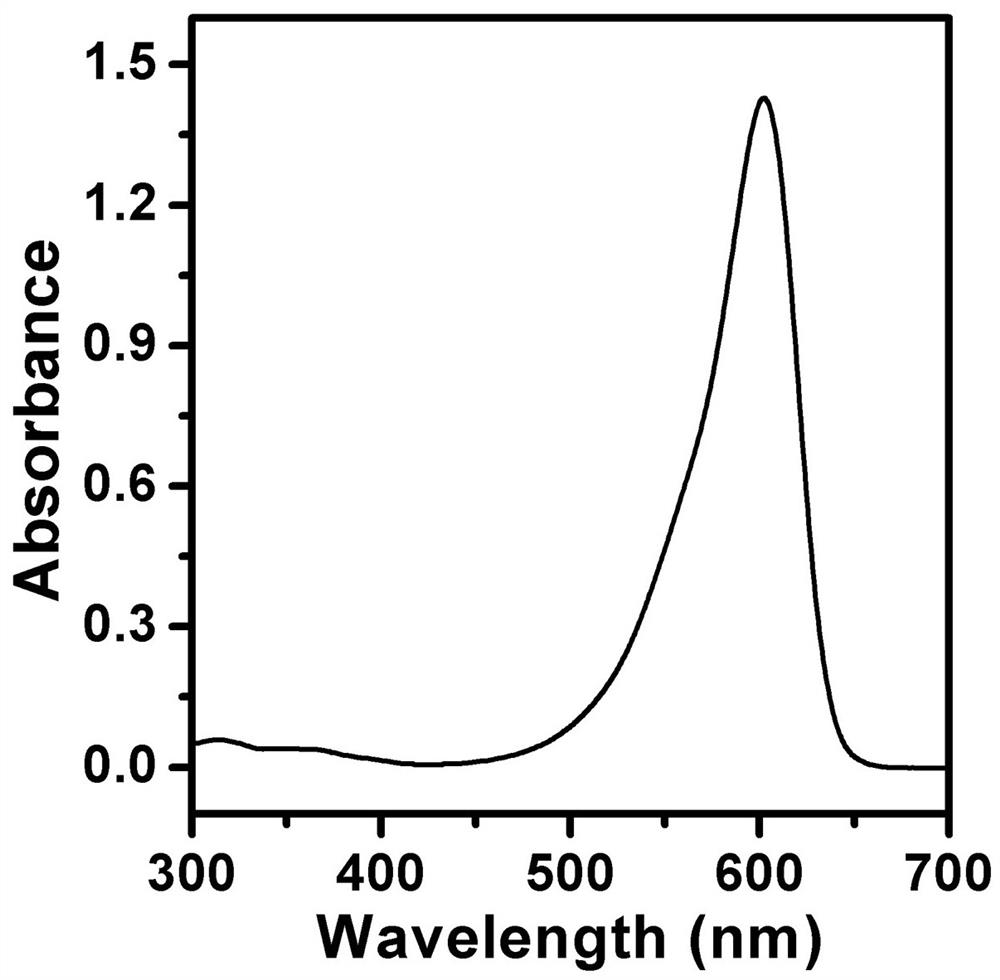Fluorescent dye emitting near-infrared light and preparation method thereof
A technology of fluorescent dyes and near-infrared light, applied in the field of fluorescent dyes emitting near-infrared light and preparation thereof, can solve the problems of short excitation wavelength, interference, difficult tissue penetration depth, etc., and achieves strong practicability, simple preparation process, low cost effect
- Summary
- Abstract
- Description
- Claims
- Application Information
AI Technical Summary
Problems solved by technology
Method used
Image
Examples
Embodiment 1
[0029] A fluorescent dye that emits near-infrared light, composed of figure 1 The reaction scheme shown in the preparation. Its preparation steps are as follows:
[0030] (1) Under argon protection, reactant 1 (0.20 g, 1.03 mmol) and reactant 2 (0.26 g, 1.03 mmol) were mixed in a Schlenk tube, and sodium acetate (4.1 mg, 0.05 mmol) was added as a catalyst, Then 3 mL of tetrahydrofuran was added as a reaction solvent, and stirred at 20 °C for 24 h.
[0031] (2) After the solvent was removed by rotary evaporation, it was purified by silica gel column chromatography, and the eluent was dichloromethane / ethyl acetate (18 / 1, v / v). A fluorescent dye emitting near-infrared light (0.32 g) was obtained with a yield of 73%.
[0032] The obtained mass spectrum of the fluorescent dye is as follows figure 2 shown.
[0033] Obtain the ultraviolet-visible absorption spectrum figure and fluorescence spectrum figure of fluorescent dye in phosphate buffered saline solution as image 3 and...
Embodiment 2
[0038] A fluorescent dye emitting near-infrared light, the preparation steps of which are as follows:
[0039] Under argon protection, reactant 1 (0.20 g, 1.03 mmol) and reactant 2 (0.30 g, 1.20 mmol) were mixed in a Schlenk tube, and ammonium acetate (38.5 mg, 0.50 mmol) was added as a catalyst, and then 3 mL tetrahydrofuran and 1 mL ethanol were used as reaction solvents, and stirred at 30 °C for 12 h.
[0040] After the solvent was removed by rotary evaporation, it was purified by silica gel column chromatography, and the eluent was dichloromethane / ethyl acetate (18 / 1, v / v). A fluorescent dye emitting near-infrared light (0.38 g) was obtained with a yield of 85%.
Embodiment 3
[0042] A fluorescent dye emitting near-infrared light, the preparation steps of which are as follows:
[0043] Under argon protection, reactant 1 (0.20 g, 1.03 mmol) and reactant 2 (0.20 g, 0.80 mmol) were mixed in a Schlenk tube, and triethylamine (0.10 g, 1.03 mmol) was added as a catalyst, and then added 3 mL of chloroform and 1 mL of acetonitrile were used as reaction solvents, and stirred at 50 °C for 2 h.
[0044] After the solvent was removed by rotary evaporation, it was purified by silica gel column chromatography, and the eluent was dichloromethane / ethyl acetate (18 / 1, v / v). 0.27 g of a fluorescent dye emitting near-infrared light was obtained, with a yield of 62%.
PUM
| Property | Measurement | Unit |
|---|---|---|
| emission peak | aaaaa | aaaaa |
| wavelength | aaaaa | aaaaa |
Abstract
Description
Claims
Application Information
 Login to View More
Login to View More - R&D Engineer
- R&D Manager
- IP Professional
- Industry Leading Data Capabilities
- Powerful AI technology
- Patent DNA Extraction
Browse by: Latest US Patents, China's latest patents, Technical Efficacy Thesaurus, Application Domain, Technology Topic, Popular Technical Reports.
© 2024 PatSnap. All rights reserved.Legal|Privacy policy|Modern Slavery Act Transparency Statement|Sitemap|About US| Contact US: help@patsnap.com










